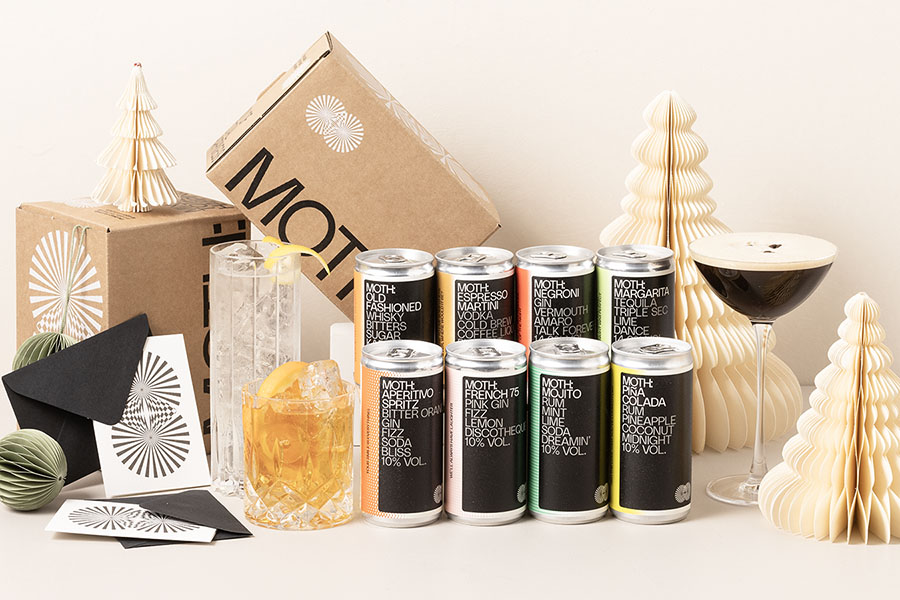RTDs are massive right now: In 2019, IWSR Drinks Market Analysis recorded the largest annual consumption increase in RTDs than in any other category in the United States.
RTDs are not a new thing, of course. One of the earliest examples is a bottled Manhattan under the brand Club Cocktails that dates to 1908. They did exist prior to the COVID-19 lockdown and shelter-in-place orders, but lockdown changed the game by closing bars and restaurants, ushering in a new era of home drinking. In this sense, lockdown became a catalyst that catapulted RTD popularity into the stratosphere.
Companies have jumped on this. In a very short time, the market has leapt from simple gin tinnies to complex cocktails and crazy creations. And there’s one focus certainly worth noting: premiumization. There is a market for ready-made, bar-strength cocktails made with quality ingredients. If there were a photo of the RTD industry right now, it might look something like a range of brightly colored cans exploding.
As a result of this growth, many producers want to start making RTDs. For producers, it is certainly alluring to create an entirely separate range of products from materials they already have. It may seem easy; however, it is not. Making RTDs is notoriously difficult, with challenges involving stability and pressure. Plus, in the UK, buyers’ expectations have been skewed by mass-produced cocktail-flavored RTDs canned around 4% ABV. This means customers often balk at the higher price of a 10% ABV cocktail, even when the ratio of price to alcohol is equivalent. Risks like these have consequences, like U.S.-based Boston Beer Company announcing in 2021 that they planned to dump millions of cases of their Truly hard seltzers, as they couldn’t sell them before they expired.
It is important to be realistic. However, there are also some incredible things going on with RTDs around the world, which makes this a very exciting time. Japan is picking up on RTDs. Suntory Spirits-owned -196°C Strong Zero is a range of highball-style drinks popular in Japan that saw four years of consecutive growth before dipping in 2021. The name derives from the process, where fruits are frozen to -196°C and crushed into a powder which goes into the liquid. Hard seltzers are not only smashing it in the U.S., but also in Australia, where the website Boss Hunting ranked the top 39 hard seltzers on the scene — no small figure. There is just so much going on, and it’s impossible to cram everything in here, so let’s focus on quality and creativity.
 Canned RTDs
Canned RTDs
Canned RTDs were a prominent feature in the early days of the modern RTD boom. Cans were seen as simple and convenient ways to enjoy drinks on the move. Ironically, however, they are very complicated to make. It takes a lot of time and investment to perfect product stability and the balance of quality to cost point, particularly in cans, which tend to contain lower-ABV RTDs than bottles and thus attract a more value-seeking consumer. The investment to have a minimum order quantity of canned products made can be a gamble, especially when you factor in the need to sell them within their shelf life, usually around 12 months. Still, we saw them popping up everywhere — and in some instances, being crushed in large quantities.
One big change I’ve seen in cans is premiumization. People are now happy to pay more for a bar-strength drink made with quality ingredients. MOTH, or Mix Of Total Happiness, have landed with a splash and are making incredible progress in very little time. The secret to their success? Premium products and impeccable branding.
A previously bottled effort that was rebranded during lockdown, MOTH canned cocktails debuted in February 2021. In a short time they have made substantial waves, popping up in supermarkets across the UK, including Waitrose, Tesco, and Sainsburys. This is exciting news because MOTH is all about quality.
The brand started with two friends making cocktails at home and realizing if there was a way of simply opening a drink of bar quality at home, they’d be buying it. They looked around online and didn’t find anything that ticked that box for them, so they decided to do it themselves.
MOTH works with brands like The Duppy Share and Tarquin’s Gin to create solid bar-strength cocktails with brand names displayed clearly on the cans, making it a collaborative effort. The ABV means higher duty and prices, but you get what you pay for. And, with the strong, simple branding, the bar-quality message is obvious.
“The brief we gave [the brand designer] was to completely ignore what other brands were doing and go our own way,” says co-founder Rob Wallis. It’s a real game changer to see their cans alongside a sea of lower cost, lower ABV RTDs. And they’ve got their feet on the ground. When I asked Rob if he planned to sell overseas, his response was that the U.K. is a big place, and there are only eleven on the team, so they are focusing on growing on their home turf before looking overseas.
Bottled RTDs
I am seeing more bottled RTDs, particularly in the larger size (500ml and up), which are being used more often for ready-made cocktails as opposed to simple carbonated combinations of spirits and mixers. Bottles do suggest an RTD to be enjoyed over time, rather than in a single sitting. That said, there are still plenty of small-bottle single serves around, like Jack Daniel’s Country Cocktails, which comprise a huge range and saw increased sales by 14.8% in 2019 according to IWSR (although the Jack Daniel’s and Cola cans are still more popular, growing a whopping 51% in 2019).
Another notable RTD producer is Hernö, a wonderful distillery based in Sweden that produces a fantastic array of gins and has won several awards for its products and the distillery. So of course, their bottled cocktails promised to be good. But they excelled even with their Word!, a take on one of my favorite cocktails, the Last Word. Being a little more obscure, I wondered how Word! sold and was curious as to the process making it, so I checked in with Head of Communications Maria Åman.
“We sold Word! for 465 SEK [around $41] in Sweden, where we launched 996 bottles. In Sweden we have a solid base with Hernö Gin collectors and shareholders that are very eager to get hold of our limited editions. Sugary and sticky are two words that can summarize the work, but it was great fun, and we are really satisfied with the result and the feedback from the market.”
Another producer that stands out is U.K.-based Cocktails In A Bottle, which is composed of the one-man cocktail factory that is Karl Wonzy. I first discovered the brand when I judged his Cake or Death cocktail for the World Drinks Awards. The cocktail is black forest gateau in cocktail form, but rather than sickly, it is divine and indulgent. It’s made with kirsch eau de vie blended with rich cherry Heering, vodka, delectable chocolate wine, salted vanilla, and citrus. Named after an Eddie Izzard sketch, it’s a wonderfully creative spin on a bottled cocktail, with all the quality and strength of a drink at your favorite bar. Wonzy explains this by saying, “I don’t want my customers to be shortchanged from bar-quality cocktails, I want to distinguish myself in this field.”
Cake or Death is just one in a treasure trove of a range of quirky bottled cocktails. You would wonder about stability and shelf life, but Karl has no issue with this, as he makes each bottle to order. Anything with a fruit content (like the Pornstar Martini, a popular drink in the U.K. made with vodka, passion fruit liqueur, vanilla syrup, and lime juice) is sent out with an advisory to drink within seven days. The way Wonzy sees it, their drinks are there to be enjoyed, not to sit on a shelf. This handmade, made-to-order approach bridges the gap between ready-made cocktails and ordering one from a person at a bar. Although you don’t watch Karl making it, you know it’s all him.
When a market is as saturated as RTDs, it creates a sense of overstimulation. There are so many brands out there screaming for attention. It’s an exciting time for consumers, since from all appearances convenience is giving way to quality as the selling point and certain products are standing head and shoulders above others. The question is whether this quality wave will die down eventually and be replaced with a race to the low-price bottom.








